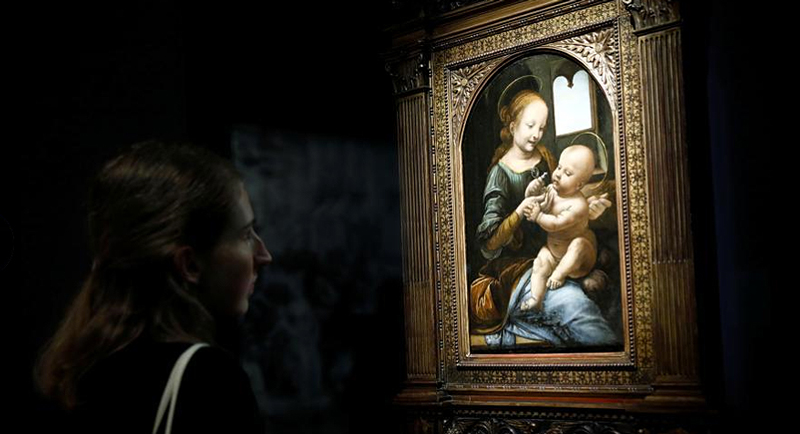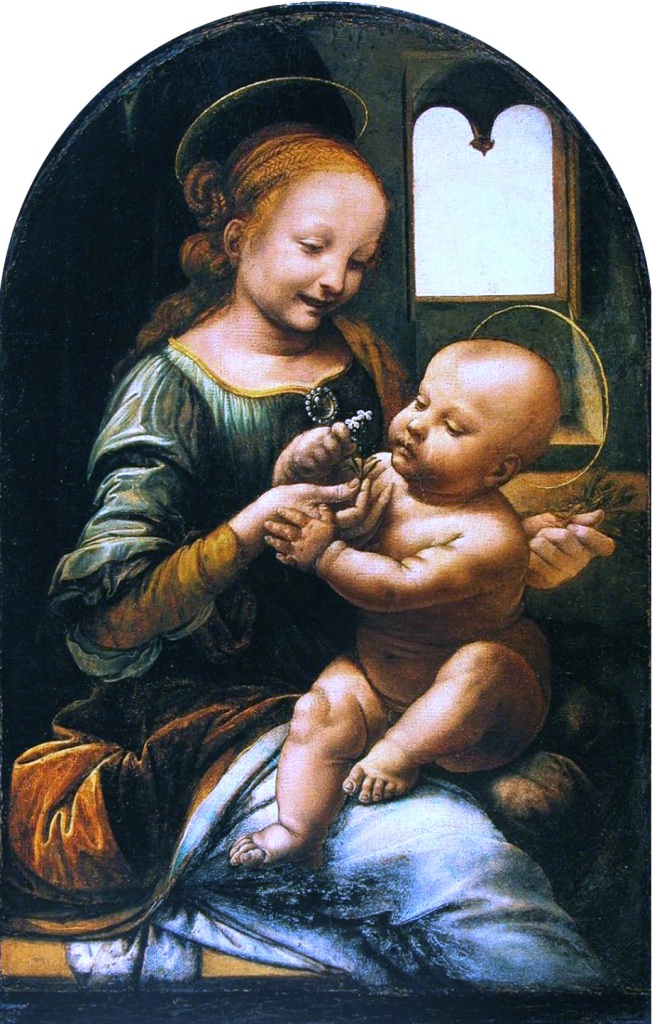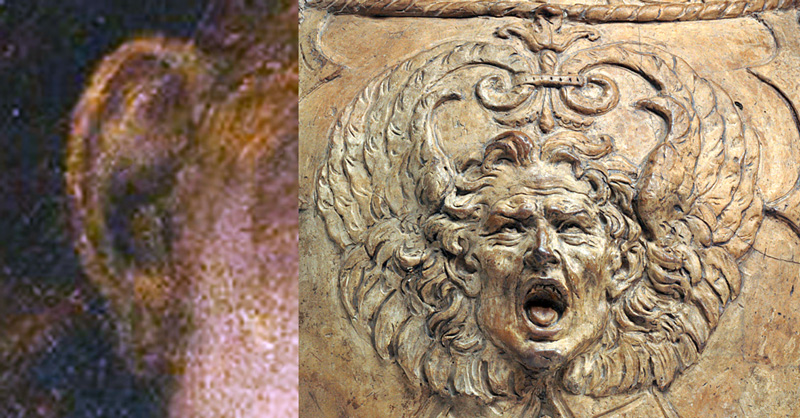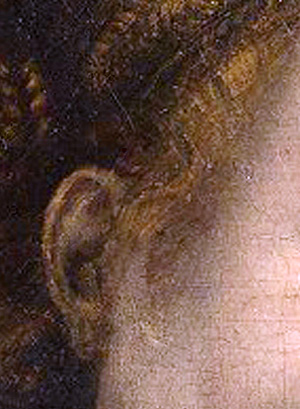
I recently read in the Washington Post that the famed portrait of Ginevra de’ Benci, kept at Washington’s National Gallery of Art, will not be crossing the Atlantic as part of the Louvre’s upcoming exhibition commemorating the 500th anniversary of the death of Leonardo da Vinci.
However, visitors to the Paris exhibition will be able to view an alternative version of the so-named Ginevra de’ Benci. The same woman sat for an earlier painting by Leonardo – the Madonna and Child with Flowers, otherwise known as the Benois Madonna. It has travelled to Paris from the Hermitage Museum in Saint Petersburg.

Hermitage Museum, Saint Petersburg, Russia.
In previous posts I presented evidence suggesting the woman identified in the portrait by art historians is not Ginevra de’ Benci but Fioretta Gorini, said to have been the mistress of Giuliano de’ Medici. It is Fioretta and her child Giulio who are portrayed in the Benois Madonna.
The painting is thought to have been started in October 1478. A note in Leonardo’s handwriting and kept in the Uffizi in Florence states (“… 1478 I started painting two Virgin Mary’s). One of these is considered to be the Benois Madonna and the date of October 1478 was around five months after Fioretta gave birth to her son. Another source states that Fioretta was likely to have been only 15 years old at the time Giulio was born. This would explain her notably youthful appearance in the painting.
Fioretta’s child Giulio was eventually taken into care by the family of one of his godparents, Antonio da Sangallo (the Elder). Although the boy was said to be the son of Giuliano de’ Medici, it wasn’t until he had reached the age of seven that Lorenzo de’ Medici, Giuliano’s brother, brought him into the Medici family to raise him as one of his sons.
Seemingly, soon after her son’s birth, Fioretta gave up her child and entered a religious community. Although there are no written records to suggest this, there are paintings by Leonardo’s contemporaries, notably Sandro Botticelli, that point to Fioretta surrendering her son and joining a religious order. Leonardo also points to this outcome in his two paintings of Fioretta – the Ginevra de’ Benci portrait and the Benois Madonna.
One of the features in the Benois Madonna painting that tempts art historians to suggest the work is unfinished, as some of Leonardo’s other early paintings, is the large vacant window above the Infant’s head. It contains nothing but the sky – no trees, no buildings, no mountains, just the sky and not even any clouds.
Such is its size and prominence that in its fnished or even unfinished state, it is there to make a statement. It contrasts greatly with the room’s dark interior, hardly adding any light to the backdrop. Light from another source appears to fall on the two figures – or does it? Could this light simply be a statement to reflect Christ’s claim as being the “light of the world”?
The window is shaped as a diptych, generally understood as a painting for an altarpiece, made of two-hinged panels that can be opened and closed like a book. In this instance what we see is almost like a blank canvas, but then it can be said that God constantly paints a new canvas – a new sky – day and night.
The diptych can also be understood as the two tablets representing the law handed down from Heaven to Moses on Mount Sinai and written in stone, referred to as the Mosaic Law or the Ten Commandments. So both Old and New Testaments (the Christ Child) are symbolised in the painting. As for the absence of any written list of heavenly commandments, Leonardo simply translates the list as an expression of the heavenly “light of God”.
When Moses was born the Pharaoh had decreed that all new-born boys of Hebrew mothers were to be drowned in the Nile. Likewise, Herod issued a similar command after the birth of Jesus, that all boys under the age of two were to be slaughtered. Following the assassination of Giuliano de Medici in Florence Cathedral and the attack on his brother Lorenzo, known as the Pazzi Conspiracy, much bloodletting took place in acts of revenge against the consiprators and anyone considered associates. They were dangerous times, and in the aftermath Pope Sixtus lV placed Florence under interdict and further attempts were made to oust the Medici’s from power. In this light it can be understood why Fioretta’s child was intially placed into the care and protection of the Sangallo family and not the Medici’s, and even why Fioretta, reputed to be the mistress of Giuliano de Medici and mother of his child, sought sanctuary and protection within the walls of a convent.
After Moses was born his mother kept him hidden for three months. When she could no longer hide him she placed the child inside a papyrus basket coated with bitumen and pitch and laid it among the reeds at the edge of the river Nile. When the Pharaoh’s daughter went down to the river to bathe, one of her servant girls noticed the basket and brought it to Pharaoh’s daughter who recognised the infant as a child of one of the Hebrews. The servant girl was the sister of the child and offered to find a nurse among the Hebrew women. She found the child’s mother and Pharaoh’s daughter asked the woman to take the child and suckle it for her. When the child grew up the mother brought him to Pharaoh’s daughter who treated him like a son, naming him Moses because, she said “I drew him out of the water”. (Exodus 2 : 1-10)
From this we can see parallels with Fioretta and her son Giulio. She kept him for a while before handing him over to the Sangallo family and then later to Lorenzo de’ Medici, de facto ruler of Florence.
The Moses narrative is usually described as “The Finding of Moses in the Bullrushes”. In Fioretta’s case the parallel is “The Finding of Jesus in the Temple” – her conversion to faith, and choosing to enter religious life..
So apart from the diptych as a reference to the tablets given to Moses, what other features in the painting point to finding the Hebrew prophet? First there is Fioretta’s basket-weave hairstyle, not only a reference to the woven basket which Moses was placed in but also to the Vinci name, which means “to entwine”. The ‘entwinement’ continues into a large knot and then flows down along Fioretta’s shoulder. The ‘flow’ start to take shape behind her ear – poorly drawn and painted, according to some critics, and not by the hand of Leonardo. The shape represents an Egyptian sphinx, crouching and protecting the neck of Fioretta.

The Egyptian sphinx is usually depicted as having the body of a lion and a man’s head. In this instance the feature shows two heads, that of a bull (found among the bullrushes), and of a human shown in the bull’s nose. The flow of hair represents the river Nile, on whose west bank Egypt’s Great Sphinx stands and guards the entrance to Giza.

The Greek version of the sphinx generally has the face of a woman and wings of an eagle. Leonardo has combined the two, Greek and Egyptian. The shoulder reference represents the wing; the flow of hair, the wind. The Egyptian sphinx was viewed as benevolent and the Greek version as cruel and malicious. Both were recognised as temple and tomb guardians.
The Greek sphinx is associated with the legend of “Riddle of the Sphinx” where travellers were allowed passage only if they could answer a riddle posed by the sphinx. If they failed to give the correct answer, they were strangled. One of the riddles was: “There are two sisters: one gives birth to the other and she, in turn, gives birth to the first. Who are the two sisters? The answer – day and night – lends itself to Leonardo’s presentation of light and darkness in the Benois Madonna painting. Notice also how close the head of Leonardo’s sphinx is to the woman’s ear. Leonardo, perhaps a riddle in himself, wrote riddles in his notebooks.
The large knot behind Fioretta’s ear represents the sphinx’s riddle – and is a reference to the Gordonian Knot associated with Alexander the Great. It impossible to untie or see how it was fastened until Alexander sliced it through with his sword. This is Leonardo’s clever way of pointing to the assassination of Giulio de Medici and the Pazzi family’s plot, with others, to overthrow the Medici family as rulers of Florence. In the attack Giuliano was stabbed several times and killed by having part of his head sliced. Lorenzo escaped death, receiving only a cut to his neck.

Fioretta’s ear, isn’t badly drawn or painted as some critics have assumed. It depicts a hooded mourner screaming in grief and anguish, possibly Fioretta herself on hearing the news of Giuliano’s murder. A similar motif appears on the terracotta bust of Giuliano made by Andrea del Verrocchio. The gorgon feature shown on the breastplate is a wailing angel with its mouth wide open. The model for the ‘guardian angel’ was Leonardo da Vinci. On the day he was assassinated, Giuliano had chosen not to wear his normal body armour under his clothes.

Leonardo has also included a second subtle ‘scream’ feature, that of Giuliano himself, made from the ‘feathered’ strands of hair hanging over Fioretta’s temple, and so pointing to Giuliano’s murder in the Temple.
These features confirm the painting was started sometime after Giuliano was killed on Aril 26, 1478, and also after the birth of Fioretta’s son a month later, supporting the the note made by Leonardo later that year that the Benois Madonna was likely to be one of the “two Marie’s” he had started to paint.
The Moses references in this painting, along with those of Giuliano de Medici, Fioretta and the sphinx are all mirrored in Botticelli’s Uffizi version of the Adoration of the Magi. Botticelli also included references from Leonardo’s unfinished version of the Adoration of the Magi and his version of Jerome in the Wilderness. The latter work is part of the current Leonardo exhibition at the Louvre.

You must be logged in to post a comment.